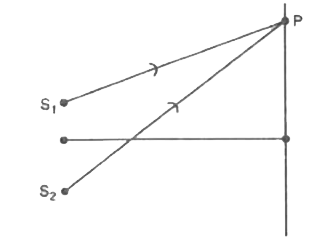In Young's double slit experiment, an interference pattern is obtained on a screen by a light of wavelength 6000 ∘A coming from the coherent sources S1andS2. At certain point P on the screen third dark fringe is formed. Then, the path difference S1P–S2P in micron isSolution in Telugu
0.75
1.5
3
4.5
The correct Answer is:b
Path difference for dark fringe,
Δx=(2n+1)λ2
∴δx=1.5 micron
Topper's Solved these Questions
Similar Questions
A tanserve wave is repsemted by the equation y=2sin(30t−40x) and the measerments of distances are in meters, then the velocity of propagation is
02:02View SolutionA man of weight 50 kg carries an object to a height of 20m in a time of 10 sec. The power used by the man in this process is 2000W, then find the weight of the object carried by the man [assume g=10ms−2]
02:04View SolutionLet S1 and S2 be the two slits in Young's double-slit experiment. If central maxima is observed at P and angle ∠S1PS2=θ, then fringe width for the light of wavelength λ will be
02:52View SolutionIn Young's double slit experiment, an interference pattern is obtained on a screen by a light of wavelength 6000Å, coming from the coherent sources S1 and S2. At certain point P on the screen third dark fringe is formed. Then the path difference S1P−S2P in microns is
03:29View SolutionAt two point P and Q on screen in Young's double slit experiment, waves from slits S1 and S2 have a path difference of 0 and λ4 respectively. The ratio of intensities at P and Q will be:
01:09View SolutionThree coherent sources S_(1), S_(2)" and" S_(3) can throw light on a screen. With S_(1) switched on intensity at a point P on the screen was observed to be I. With only S_(2) on, intensity at P was 2I and when all three are switched on the intensity at P becomes zero. Intensity at P is I when S_(1)" and" S_(2) are kept on. Find the phase difference between the waves reaching at P from sources S_(1) "and" S_(3) .
View SolutionIn the case of light waves from two coherent sources S_(1) and S_(2) , there will be constructive interference at an arbitrary point P, the path difference S_(1)P - S_(2)P is
View SolutionIn an interference pattern the path difference between waves starting from S1 and S2 and reaching at P is 1.5 microns i.e. S2P−S1P=1.5 microns. If the wavelength of light used be 6000Å, then the point P is :
 View Solution
View SolutionAt two points P and Q on a screen in Young's double slit experiment, waves from slits S_(1) and S_(2) have a path difference of 0 and (lambda)/(4) respectively. The ratio of intensities at P and Q will be
View SolutionTwo coherent point sources S1 and S2 are separated by a small distance 'd' as shown. The fringes obtained on the screen will be :
05:00View SolutionIn a modified set up of Young's double slit experiment, it is given that SS2−SS1=λ4 i.e., the source S is not equidistant from the slits S1andS2.
(a) Obtain the condition for constructive and destructive interference at any point P on the screen in terms of the path difference Δ=S2P−S1P.
(b) Does the observed central bright fringe lie above or below O ? Give reason in support of your answer.02:11View SolutionAt two points P and Q on a screen in Young's double slit experiment, waves from slits S1andS2 have a path difference of O and λ4 respectively. The ratio of intensities at P and Q will be ......
02:13View SolutionIn the case of light waves from two coherent sources S1 and S2, there will be constructive interference at an arbitrary point P, the path difference S1P−S2P is
03:12View SolutionIn Young’s double-slit experiment, an interference pattern is obtained on a screen by a light of wavelength 6000overset@A , coming from the coherent sources S_1 and S_2 .At certain point P on the screen, third dark fringe is formed. Then the path difference S_1P-S_2P in microns is
01:18View SolutionIn Young's double slit experiment, an interference pattern is obtained on a screen by a light of wavelength 6000Å, coming from the coherent sources S1 and S2. At certain point P on the screen third dark fringe is formed. Then the path difference S1P−S2P in microns is
03:46View Solution

